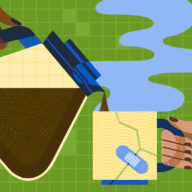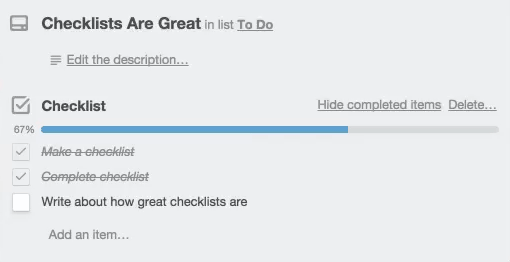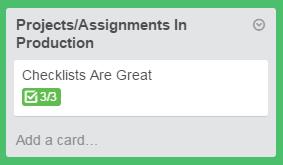Is there anything more satisfying than completing a long checklist of to-do tasks? The simple act of crossing off items on your to-do list is a blissful feeling.
Whether you’re Type A or Type Z, we all need checklists to keep track of our many professional and passion projects—especially when they involve several moving parts and multiple team members.
If you think you’re the only one who feels a sense of accomplishment and satisfaction after checking that last box on the list, think again! Our team at Mainstreethost uses Trello checklists to track the progress of short and long-term projects. We get pretty excited when that little green icon shows up on the project’s card because it means we’ve finished all the items on our lengthy list and the project is done!
Accomplishing tasks and completing goals is more than a cause for celebration. There’s a reason why we get excited over this sense of success. Let’s explore this simple, yet powerful psychological motivators.
Setting Smart, Bite-Sized Goals
Big goals are important. They give you and your team something to work towards. But small goals are important, too. Once an overarching plan has been established (“Let’s work on increasing traffic to our website’s blog,” for example), it’s time to set small, achievable tasks for everyone. These are called “SMART” goals, and they’re defined as:
- Specific
- Measurable
- Attainable
- Realistic
- Time-bound
Use your smart goals as a guiding light to organizing lists and tasks. Checklists should be made up of small, actionable tasks that feel doable to the individuals and teams working to complete them.
Small goals are also inherently short-term, which is beneficial when trying to accomplish big tasks. Bigger goals usually take some time: they tend to be complicated, challenging, and require patience. It’s common for people to get frustrated when the process takes longer than they were expecting, which is a big reason why people give up mid-project.
Breaking down your projects into smaller, bite-sized pieces helps you stay motivated and positive throughout the process.
So, What’s Going On In Our Brains?
Dopamine, that’s what.

Motivation is the essential and irreplaceable element of success. When we’re not motivated, we fail. Haven’t we all felt that mid-task slump?
When we experience even small amounts of success, our brains release dopamine, which is connected to feelings of pleasure, learning and motivation. When we feel the effects of dopamine, we’re eager to repeat the actions that resulted in that success in the first place. Neuroscientists refer to this as “self-directed learning.”
When we are positively motivated to do something, we learn to take that same action to receive the same feeling. This is why achieving small goals is such an effective way to stay motivated during long-term projects and processes.
Checking items off of a checklist releases small amounts of dopamine that then fuel us to keep checking off more items, i.e. get more done! Raise your hand if you’ve ever written a task down just to immediately check it off? ♂
But checklist items have to be actual, substantial tasks to be effective in actually accomplishing your to-do list or getting closer to the project end date.
Slice And Dice Your To-Do List With Excitement
I can pretty much guarantee that you’ve all experienced gamification at some point, even if you’re not familiar with the term.
It’s a process that takes normal, mundane tasks and turns them into “fun” activities with elements like competition and rewards systems. This idea is used by many industries, fields, and platforms that may surprise you, and one example of this idea in practice is a checklist.
When working on a checklist, you complete actions and tasks to receive a type of reward. While not in the traditional sense, a completed project and completed checklist are both examples of something our brain would view as “rewards.”
Think about your smartphone. If you have a pedometer app, you might earn a golden ribbon for completing your step goal that day. In the same line of thought, Trello gives you a green, completed icon whenever a checklist on a card is finished.
These rewards might seem a little silly or trite, but our brains respond to satisfying markers of success like this—and push us to achieve more because of it! A crucial aspect of gamification, however, is that the rewards given must actually be earned. This isn’t because of any honor system amongst colleagues. It’s because people can sense when they haven’t really earned a reward, and this feeling makes the reward seem less meaningful.
If the tasks on your checklist are unchallenging, the result will be unsatisfying. Triggering the dopamine response requires some sincere effort. So while I did say that small goals are more effective than large ones, they must be big enough so you experience at least some sense of satisfaction and pride in completing them. For example, emptying the dishwasher every morning is an accomplishment, but may not give you the same feeling of satisfaction like writing the first five chapters of your novel.
Checklists For Anything And Everything
People use checklists for all sorts of things: packing for vacation, onboarding a new hire, keeping track of homework assignments, or organizing their stamp collections. The possibilities are truly endless. And checklists can be especially useful in a professional setting when dealing with highly complicated and collaborative projects.
For example, our team uses Trello’s checklist feature to mark progress on long-term content pieces like ebooks. With an ebook, the actual writing of the piece is, of course, very important. But what about all the other stuff that goes into the production and dissemination? We have several people working on several different aspects of the project, and shared checklists on Trello are the perfect way to manage this workflow.
Each one of these items presents its own unique obstacles that must be tackled. Checking an item off of the list is immensely satisfying for everyone involved – and then it’s on to the next item!
Workflows like this are applicable in any field or industry. All it takes is some team-wide collaboration and strategic thinking to get one of these bad boys going. Your team should also buffer in some time once per month to evaluate and analyze progress as well as celebrate these successes.
Get Out There And Make Some Lists!
By understanding the psychological reasons and motivators, our team’s love for Trello’s green checklist icon makes complete sense. Not only does a completed list signify that a lengthy project is over – it means that we accomplished something real and meaningful. Each checklist item was a challenge (large or small) that we overcame.
So the next time you feel amazing after checking all the items off of a to-do list, you’ll know exactly why. Keep on making those lists!
Good or bad, we’d love to hear your thoughts. Find us on Twitter (@trello) or write in to support@trello.com
Next: What’s Microproductivity? The Small Habit That Will Lead You To Big Wins













































